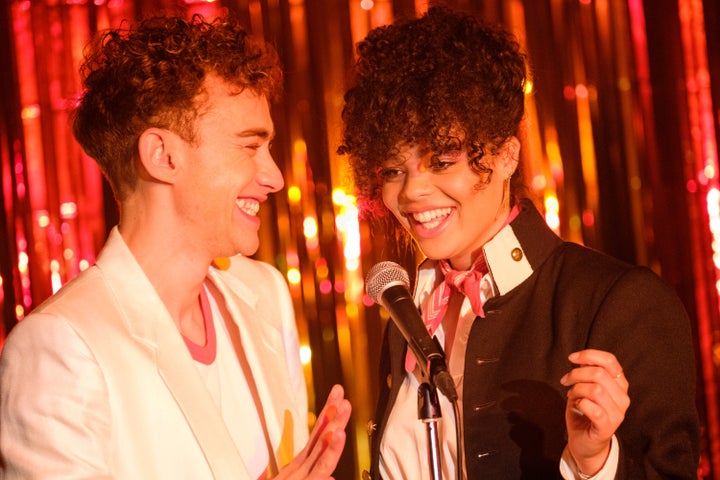
“La!”
The notifications on my phone were spilling over with the same comment from all my queer friends after they watched Russell T Davies’ new show, It’s A Sin. Some I hadn’t heard from in nearly a decade. They sent just one word: “La!”
It needed no explanation. The central group of gay men who feature in Channel 4′s landmark drama about the 1980s AIDS pandemic say it to one another as they go to work in the mornings and arrive home in the evenings. They say it before they go out to parties and when they return in the middle of the night with new queer allies. In episode one, Olly Alexander’s Ritchie gets all dragged up to sing the single note to a roomful of people.
“La!”
Fun, cosy and camp, it epitomises the way queer circles have used coded language, both historically – for protection from bigoted groups – and in more modern and accepting times as a sign of self-identification, solidarity and fun.
“They're like memes, aren't they really. Maybe they're the precursor of the online meme”
- Princess Julia on the secret gay language of the 1980s
“They’re like memes, aren’t they really. Maybe they’re like the precursor of the online meme,” Princess Julia, DJ, writer and fashion icon who was on the scene in the 1980s and still is today, tells HuffPost UK.
“If you’re in a little gang definitely there’s mannerisms and things that you pick up off each other. It’s in friendship groups. Maybe that’s part of Russell’s story.”
It was indeed: speaking on It’s A Sin’s companion show After Hours, the Queer As Folk and Doctor Who writer said: “I did that as a little camp kid in Swansea... Me and my gang of mates, when we were teenagers we all belonged to the same youth theatre and that was one of our jokes.
“There was some people out there who I haven’t seen for years who might watch this and go, ‘I used to do that, I used to go, “La”.’ How they explain that to their wives, I would love to know.”
Queer historian Dr Justin Bengry, who convenes the MA in Queer History at Goldsmiths, says the use of queer coded language has always been “critically important” for LGBTQ+ people.
“Queer people have long used coded language to speak to one another discreetly, avoid detection where they might be unsafe, and to identify others like themselves,” he says, explaining that in the 19th century and into the middle of the 20ths, the dominant queer language was Polari, “made up of a combination of backwards talk, theatre and underworld slangs.”
While these days that sort of explicit separation of language isn’t necessary in many Western societies, queer language still pervades, Dr Bengry says. ″Today, queer people still play with language, with irreverence and fun, to celebrate our communities, and while many of us need not worry actively about our safety, many must still rely on code, doublespeak, and slang to remain safe.”
Roy Brown, a model and musician, remembers hearing Polari being used by older LGBTQ+ people when he was “fresh on the scene” in the mid-80s.

“I used to hear my contemporaries say ‘purp mom,’ which I think [meant] ‘Hello darling,” I understand. And lines like ‘nah da to varda in the larder,’ which either means no food in the fridge, or the person you’re cruising has nothing going on. ‘Bona lallies’ means great pair of legs and ‘pumping Irenie’ means fit body.”
Brown reflects with hindsight on the significance of this “almost underground” language – “a form of communication between groups of gay men and the few women who were privy in those circles to have a conversation without being busted for being gay!” he says. “Especially if the conversation was more intimate, like hooking up with one another outside of your own environment.”
But Polari, like all languages, evolved, and began to morph into the fun, sassy turns of phrase used by queer groups today. “By the 1980s such secrecy was no longer necessary,” says Mark Wardel, a prominent artist from the period, who designed masks of David Bowie that have featured at the V&A.
“Everyone was referred to as ‘she’ whether male or female, no matter how ‘butch’ they thought they were.”
- Mark Wardel
“One quirk of the scene was that everyone was referred to as ‘she’ whether male or female, no matter how ‘butch’ they thought they were,” says Wardel. “The use of ‘she’ and female names for men was widespread in the show business world with the likes of Elton John and Rod Stewart calling each other Sharon and Phyllis.”
Professor William Leap from the American University, Washington, says of “La!′ that he “wouldn’t call it coded” because queer language has advanced to the point where its primary function is no longer about being secretive. “It doesn’t need to be coded to be effective. If it were coded, it would draw undue attention to itself – like Polari does, and would make obvious the fact of attempted secrecy,” he explains.
“But by being obvious, that is discrete. It can be simply a hello/goodbye comment to everyone in the room. It can also express additional meaning to those who understand the rest of the discretionary message,” says Leap.
Which is all to say that queer people are the kings and queens of having more than one meaning for a word and gender swapping remains a prominent in-joke among queer circles today – including mine. Davies’ use of “La!” in It’s A Sin is a delightful way of introducing the idea of cheeky coded language to non-queer audiences – and it lets them in on our joke.
* This article was amended on January 29, 2021 to reflect the correct spelling of the Polari word, ‘bona’.